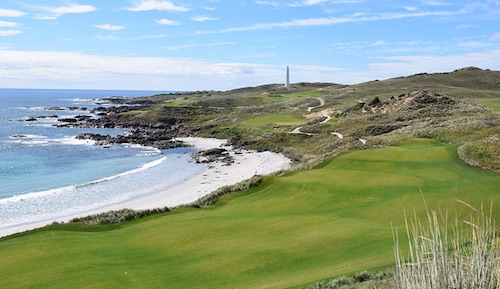
Cape Wickham: We interrupt this view because you're on the tee...
If you build it, they will come.
That mantra worked for Mike Keiser at the wildly successful Bandon Dunes Resort in Oregon, which some people thought was too remotely located to succeed when it opened for play in 1999. I'm not sure if the same thing will happen at Cape Wickham, located on King Island, off Tasmania in Australia. But I can tell you after my visit, that the No. 24 world ranking isn't far off the mark.
And unlike Pine Valley, Augusta National, and Cypress Point, Cape Wickham can be played twice in the same day for $195 AUS by anyone who is willing to get there. In my group's case the round at Cape Wickham was part of a two day side trip from Melbourne, our main destination Down Under. Eight of us took a private charter from Melbourne to the main island of Tasmania to play Barnbougle Dunes and Lost Farm the first day. We dined and stayed at the wonderful Lost Farm Lodge after playing both courses the first day. Like Bandon Dunes, both links courses appear to have been in place for a hundred years -- such is the nature of the links land they were carved out from. Landing on a dirt airstrip alongside the second fairway of Barnbougle Dunes only added to the charm, and got us on the tee within 30 minutes of landing.
The following morning we flew to King Island, rented a van, and took the 45-minute drive to Cape Wickham, on a road barely wide enough for two cars, with hundreds of cattle grazing the rolling, grassy landscape. Sandy blowouts in the landscape appear occasionally, looking exactly like natural bunkers. And then it appears, the sign to Cape Wickham and small temporary clubhouse with one of the best views in golf. To the left is the first fairway, to the right the 18th. Both wrap around the beach -- but play at different elevations.
The first hole of the Mike DeVries-designed course is a gentle par 4 with a fairway sitting high above the ocean on the right where teeing off from the practice putting green adds to the first tee jitter level. From there it's good hole (and view) after great hole, with a highlight the par-5 9th, one of the best I've played.
The downhill tee shot facing straight towards the ocean is straightforward enough, but the layup requires choosing the wide fairway on the left or navigating dunes on the right to provide a closer approach. Going for the green in two brings all sorts of numbers into play, and I was really impressed when my playing companion Mark, at 4-under gross, still went ahead and reached for the 3-wood. (He found a dune and made bogey.) The firm green slopes into oblivion long, with only a cavernous bunker to stop the ball. (I found it.) There is an unplayable cavern on the left, and huge slope of tightly mown grass on the right. I can't remember ever making double bogey and loving the hole, but I did after playing this beauty.
The return to the clubhouse is after the 13th hole, and the next five bring you closer and closer to the water, until after playing the par-5 15th you wind up at the tee of the No. 1 handicap hole, No. 16 (shown above). Continuing back to the clubhouse the 17th is one of the most scenic one shotters anywhere, and the crescent shaped fairway of the 18th is bordered by the beach on the right replete with stairs for slicers to try and play their shots into the green.
I ran into the owner, Duncan Andrews, standing outside the clubhouse. I told him that I enjoyed the relatively wide fairways, which meant we didn't have to spend our day searching the tall grass and avoiding Australia's poisonous snakes.
"This land will never host a major," he said. "So why make it difficult for the 20 marker?"
I have no doubt that golfers are going to seek out Cape Wickham, and it's newer King Island neighbor Ocean Dunes, set to fully open soon. If you're travelling from the other side of the world like I was, I recommend spending as much time in Australia as you can. It's the trip of a lifetime.